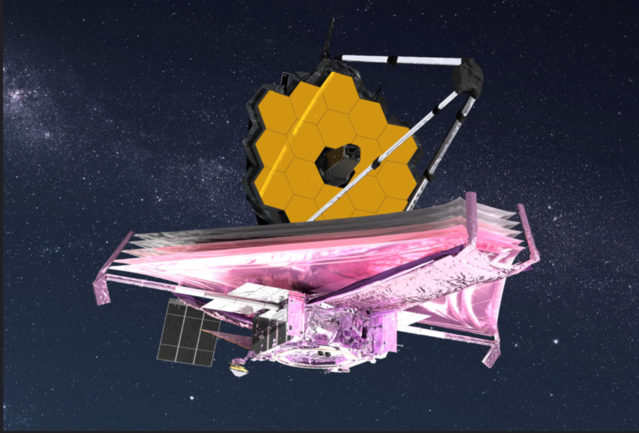Psychology
How Will the James Webb Telescope Impact Human Psychology?
A powerful new space telescope is about to introduce us to the cosmos.
Posted March 17, 2022 Reviewed by Vanessa Lancaster
Key points
- The most powerful space telescope ever built has begun its multi-year mission to peer deep into time and space. We may never be the same.
- Unprecedented data and images from the James Webb Space Telescope may inspire a significant cognitive upgrade for humankind.
- A new understanding of dark matter and dark energy may allow us to better understand ourselves.

It would be wise for all sentient life on Earth to follow the work of the James Webb Space Telescope (JWST) over the next several years. Launched December 25th last year, the largest and most powerful space telescope ever built is now in its sweet spot orbiting the Sun a million miles from Earth.
JWST is likely to reveal new and deeper layers of the cosmic story, which may necessitate a few profound psychological adjustments for humankind.
Unlike its predecessor, the Hubble Space Telescope, JWST relies primarily on infrared. According to NASA, JWST is so sensitive it could spot the heat signature of a bumblebee on the Moon from Earth. It will be capable of detecting light at extreme distances, in regions we have never seen, even through immense dust clouds in space. JWST is expected to rein in light from the formation of planets, stars, and some of the oldest galaxies.
We may be about to enter a new age of discovery. Dark energy, for example, makes up about 70 percent of the universe, and dark matter accounts for about a quarter of its mass. This means 95 percent of the universe is beyond our current understanding. JWST has the potential to chip away at those mysteries and possibly discover signs of extraterrestrial life.

Seth Shostak, senior astronomer at the SETI Institute (Search for Extraterrestrial Intelligence) and author of Confessions of an Alien Hunter: A Scientist’s Search for Extraterrestrial Intelligence, adopts the wise wait-and-see posture but does acknowledge exciting possibilities. He said:
"The telescope is primarily intended to do cosmology, to observe the earliest few hundred million years of the universe. But it’s also possible that this same telescope can find biomarkers in the atmospheres of relatively nearby exoplanets. If we were to detect oxygen in some other planet’s air, we would likely be able to say that the universe is chock-a-block with lettuce or some other photosynthetic life form."
Even more intriguing, Shostak added, is the possibility of JWST discovering evidence of intelligent life or synthetic intelligence. “There’s the chance that we’ll find evidence for a Kardashev Type II or Type III civilization [society with ultra-advanced technological abilities] in a neighboring star system. That would be truly spectacular.”
Shostak explained that a largescale technological civilization might present some sign of its presence that JWST could identify.
"Advanced societies might build really large structures, detectable by their heat signatures,” he said. “Finding a Kardashev civilization by detecting its waste heat—either from a Dyson sphere or swarm, or something similar—would do more than merely contribute to SETI. That would show that we’re neither the only kids on the block nor are we the most advanced."
The Time Machine
JWSTs’ reach is so deep that it will transport human vision billions of years back in time. Its primary mirror is 6.6 meters (21.7 feet) across, with a total collecting area of more than 25 square meters (approx. 270 square feet).
This is much more than Hubble’s 4.5 square meters (approx. 50 square feet). JWST will seek out light from 13.5 billion years ago, a time tantalizingly near the Big Bang 13.8 billion years ago. Nothing is guaranteed, of course, because space is hard. But it is reasonable to anticipate amazing discoveries and spectacular images from Webb. Shostak:
"Always hard to predict what a new instrument will show you. But in astronomy, every major new telescope has turned up something both unexpected and dramatic in the universe. I don’t doubt that JWST will do the same, and it might conceivably have a legacy that transcends that of anyone who was alive when it was launched!"
New Perspectives
The dawning realization that the Earth was spherical rather than flat impacted countless human affairs. Five centuries ago, when Copernicus argued that the Sun was at the center of the solar system and not us, humankind was offered a cognitive upgrade and an opportunity to mature.

A photograph from the Apollo 8 mission in 1968 shocked billions with a perspective-altering Earthrise as seen from lunar orbit. In 1972, from a distance of about 18,000 miles away, an Apollo 17 astronaut took a photo of the Earth that later would be named “The Blue Marble.” That single unprecedented image of an illuminated Earth in full jolted billions into contemplating the beauty and fragility of our tiny home in the dark expanse.
What will the James Webb Space Telescope teach us? What new questions will emerge? How will waves of new knowledge and long-range detailed views of the universe affect our concept of home? Will JWST nudge us closer to becoming citizens of the cosmos? Will things we learn and see propel our species closer to reality and further away from the superstitions and shared delusions of a species so long marooned on a lonely world?
This is an exciting moment in human history. Collectively, as a species, we are standing at the mouth of the deepest and darkest cave of all. As we lean in and turn on the flashlight, we can be confident that wonderful secrets await.
References
Recommended Reading:
- Pale Blue Dot: A Vision of the Human Future in Space, by Carl Sagan
- Cosmos, by Carl Sagan
- Dark Matter and Dark Energy: The Hidden 95% of the Universe, by Brian Clegg
- Confessions of an Alien Hunter: A Scientist’s Search for Extraterrestrial Intelligence, by Seth Shostak
- Brief Answers to the Big Questions, by Stephen Hawking
- Entering Space: Creating a Spacefaring Civilization, by Robert Zubrin
- Astrophysics for People in a Hurry, by Neil deGrasse Tyson
- WHERE IS EVERYBODY?: Seventy-Five Solutions to the Fermi Paradox and the Problem of Extraterrestrial Life, by Stephen Webb
- Until the End of Time: Mind, Matter, and Our Search for Meaning in an Evolving Universe, by Brian Greene
- At Least Know This: Essential science to enhance your life, by Guy P. Harrison




